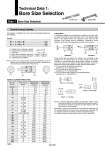
2-m27-49_en 27 / 34
10秒後にBOOKのページに移動します
Stationary Operation Fig. 1 η = 0.7 or less Fig. 2 η = 0.5 or less Fig. 3 η = 1 or less Formula F1 = η x A1 x P ・・・・・・・・・・・・・・・・・・・・・・・・・・・・・・・・・(1) F2 = η x A2 x P ・・・・・・・・・・・・・・・・・・・・・・・・・・・・・・・・・(2) F1: Cylinder force at extension side [N] F2: Cylinder force at retraction side [N] η: Load ratio A1: Piston area at extension side [mm2] → Refer to “Table (1)”. A2: Piston area at retraction side [mm2] → Refer to “Table (1)”. P: Operating pressure [MPa] 4 (CJ1) 68 10 12 16 20 25 32 40 50 63 80 100 125 140 160 180 200 250 300 2 3 5 4 6 5 6 (CJP2) 8 (CQ2) 8 10 (CQ2) 10 12 (CQ2) 12 16 (CQ2) 14 (CM2) 16 (CA, CQ2, CG) 20 20 25 30 32 (CS2) 36 32 (CS2) 36 38 (CS2) 40 40 (CQ2) 45 40 (CQ2) 50 60 70 12.6 28.3 50.3 78.5 113 201 201 201 314 314 491 491 804 804 1260 1260 1960 3120 5030 7850 12300 12300 15400 15400 20100 20100 25400 25400 31400 31400 49100 70700 9.4 21.2 30.6 66.0 84.8 181 173 151 264 236 412 378 691 603 1100 1060 1650 2800 4540 7150 11500 11300 14600 14400 19000 18800 24200 23900 30200 29500 46300 66800 Bore size D [mm] Piston rod size d [mm] Piston area at extension side A1 [mm2] Piston area at retraction side A2 [mm2] Table (1) Cylinder Piston Area Double Acting Cylinder The relation of cylinder force, bore size and operating pressure is the following. Load ratio η In selecting a cylinder, do not forget that in addition to the load, there are many forces that act upon the cylinder. Even in the stationary state shown in the diagram below, the resistances of the seals and the bearings in the cylinder must be subtracted. Furthermore, during operation, recoil due to the exhaust pressure also come into play. These forces that act against the cylinder vary according to the conditions of the cylinder such as its size, pressure, and speed. Therefore, it is recommended to always select a cylinder of a larger size. Thus, select an air cylinder so that the load factor, which is a factor that is used in the selection process, will be as shown below. 1) To use a cylinder for stationary operations: load factor η = 0.7 or below (Fig.1) 2) To use a cylinder for dynamic operations: load factor η = 0.5 or below (Fig.2) 3) To use a cylinder with a guide for horizontal operations: load factor η = 1 or below (Fig. 3) Data 1 Bore Size Selection Series CJ2 Series CM2 Note) As shown in the diagram below, the pressure receiving area on the retraction side of the double acting single rod cylinder is reduced by the amount of the cross sectional area of the piston rod. Note) If a dynamic high-speed operation is particularly needed, further reduce the load factor. Then, the cylinder will have power to spare for the amount by which the load factor has been reduced, which will make it easier to produce speed. Meanwhile, a cylinder force that has been calculated by multiplying only the operating pressure by the pressure receiving area, assuming that no resistance exists in the cylinder, is called a “theoretical output”. For details about the theoretical output, refer to Data 3, page 1825. Technical Data 1: Bore Size Selection 1820